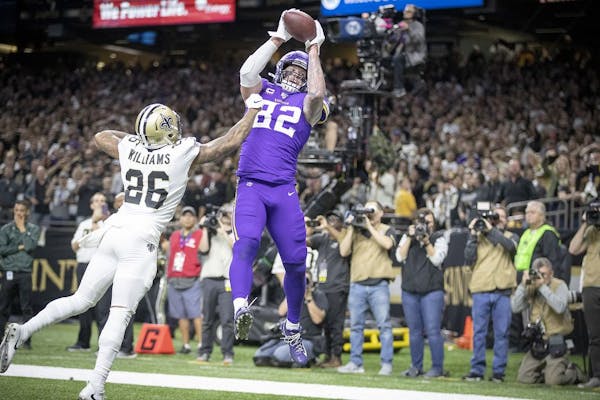Well after the Vikings had returned from their NFC wild-card victory over the Saints on Sunday, Mike Zimmer said he actually took a minute to stop, recall who else was still in the conference's playoff field — and realized that many of those teams look similar to what the Vikings are doing on offense.
"I was actually up in the defensive room, and I was sitting there trying to remember who is left," the Vikings coach said Monday. "There are a lot of running teams that are in there, so yeah, I think it's different from what a lot of teams are doing. I think it can be effective."
The Vikings' grand plan to revamp their offense in 2019, after a lost 2018 season in which they fired offensive coordinator John DeFilippo with three games to go, revolved around bringing back a fairly traditional strain of the West Coast offense that new assistant head coach Gary Kubiak had used to win as an offensive coordinator under Mike Shanahan in Denver and as a head coach in Houston.
Now, if they want to reach the Super Bowl, they will have to do so by stopping teams with philosophies similar to their own.
Shanahan's influence runs strong through three of the four teams still playing in the NFC, where Kubiak helped shape the Vikings attack that his son, Kyle, will try to stop in the NFC divisional playoffs on Saturday. Kubiak employed both Kyle Shanahan and Packers coach Matt LaFleur in Houston, and Cousins worked with both Shanahans, LaFleur and Rams coach Sean McVay while he was in Washington. The Seahawks — the NFC's other remaining team — also base their offense around West Coast principles with coordinator Brian Schottenheimer.
The schemes have followed different strains — the Vikings' approach hews closer to the one the 49ers used in the 1980s and the Broncos in the 1990s, while Kyle Shanahan's current scheme evolved from his time with Robert Griffin III in Washington and Matt Ryan in Atlanta and features lots of pre-snap motion and creative uses for his skill players — but there are some notable similarities between the Vikings and their opponent this weekend.
Flush with fullbacks
The 49ers and Vikings, according to Sharp Football Stats, are two of only four teams in the NFL who have three receivers on the field less than 60% of the time; another (Baltimore) is the top seed in the AFC playoffs. Their fullbacks — Kyle Juszczyk of the 49ers and C.J. Ham — are on the field more than any others in the league.
"The one thing about when you have two backs in the game, for instance, like C.J. or these guys — [the 49ers] have the same basic thing," Zimmer said. "They put the fullback out wide and now they open up the formation and they try to get a matchup with a corner or a linebacker. Really, might be in two backs or backs in protections, now it's one back and it's zone read, could be whatever, so there's a lot of variables to it where you can move players and different positions. It all kind of started way back with Bill Walsh in San Francisco and Mike Shanahan and now Kyle [Shanahan] and Gary [Kubiak] and these guys."
Despite all the shared history between the coaches, and the common influences that inform their schemes, Kyle Shanahan doesn't necessarily accept the premise that the 49ers and Vikings (and the Packers, for that matter) are offensive cousins.
"They're all so different," said Kyle Shanahan, who was born in Minnesota in 1979 while his father was a Gophers assistant coach. "If you call plays like we do, verbiage-wise, I guess it's considered West Coast. I did a little bit more of that when I was with [Jon] Gruden, when I went to be with [Gary] Kubiak. He ran more of my dad's offense than they did in Denver, which originated from San Francisco and the verbiage, but you change it based off teams you're going against, and fronts you're going against. I have a hard time, always, when people try to categorize our offense as something. There's a foundation to what we believe in, but at least for me personally, our offense is totally predicated on what we're going against."
Close quarters
Kyle Shanahan was Washington's offensive coordinator when the team took Cousins in the fourth round of the 2012 draft; he had moved on by the time Cousins became a full-time starter in 2015. At one point, conventional thinking around the NFL had the two reuniting in San Francisco once Cousins left Washington. Instead, the 49ers traded for Jimmy Garoppolo and Cousins ended up in Minnesota.
The Vikings cut Cousins' passing attempts by an average of eight per game this season.
"They don't throw it as much, which has made them tougher to beat and a better team," Shanahan said on Tuesday.
As for the idea that the team can't win big with Cousins, though, Shanahan said, "I just laugh at it.
"Kirk's won plenty of big games. I just watch how people look on tape, and I go with how good they look, not what their record is on Monday night.''
On Saturday, as Cousins tries to win his second playoff game, he'll have to beat a coach that knows him as well as anyone. The Vikings' path to the Super Bowl could have him trying to get past two of his former coaches.
Whatever challenge all that familiarity presents will have to be overcome through nuance.
"It's just individual wrinkles to plays — make something look like it did the week before, the year before, and then do something different," Cousins said. "That cat-and-mouse game will be going on as long as there's football."
